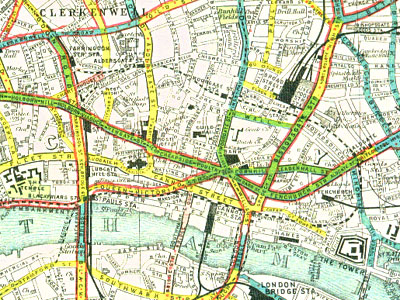Blog
Occasional posts on subjects including field recording, London history and literature, other websites worth looking at, articles in the press, and news of sound-related events.
Noisy streets of London
LAST MAY THE Times ran an article about new EU rules in the pipeline for electric vehicles, requiring them to be fitted with engine noise simulators so they don’t run over blind pedestrians or the unwary. Smurf cars plus Brussels made an irresistible target for Clarkson:
This is reasonable enough for cars moving swiftly and at constant speed on motorways, but electric cars really do seem quieter in urban settings. Milk floats weren’t battery-powered on a whim. Even so, road surfaces add to the inescapable auditory fog of traffic in cities. There’s a trade-off among different grades of tarmac between surface noise and grip.
What were road surfaces like a hundred years ago and how noisy were they? Most people might guess they were entirely made up of cobblestones, like the ones which survive in Little Green Street in Kentish Town and a few other places. Not so – road types in the capital were so varied that Bartholomew published a Road Surface Map for 1909, with a later edition for 1929. Here’s a bit from the 1909 one:

You can see a much bigger section among London Sound Survey’s Historical pages. Don’t say we don’t treat you! The colour-coding is: blue for granite setts (small blocks) or cobbles; green, asphalt; pink, macadam (hard to make out and the least common surface type); and lastly yellow for wood.
Granite setts and cobbles were often described as noisy beneath traffic. Wealthy residential neighbourhoods in the 19th century had their cobbled streets watered to reduce the racket of hooves and iron-rimmed wheels. Wooden block paving was, for a while, held up as the way forward in being quieter and cleaner. This was helped by the import of Australian hardwoods and better wood preservation methods.
Every city is a work in progress and the Road Surface Map shows this for London, with cobbles and setts being replaced by newer surfaces. You can see how this happened sooner in high-status areas away from industry. Road surface noise alone would have helped you guess what class of neighbourhood you were in.
ABOUT SOUND
FIELD RECORDINGS
The balloonist in the desert is dreaming
The Binaural Diaries of Ollie Hall
GEOGRAPHY AND WANDERINGS
The Ragged Society of Antiquarian Ramblers
LONDON
ORGANISATIONS
Midwest Society for Acoustic Ecology
World Forum for Acoustic Ecology